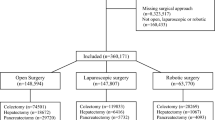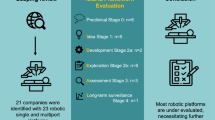Abstract
Robotic-assisted kidney transplantation (RKT) with the Da Vinci (Intuitive, USA) platform has been recently developed to improve outcomes by decreasing surgical site complications and morbidity, especially in obese patients. This potential paradigm shift in the surgical technique of kidney transplantation is performed in only a few centers. For wider adoption of this high stake complex operation, we aimed to develop a procedure-specific simulation platform in a porcine model for the training of robotic intracorporeal vascular anastomosis and evaluating vascular anastomoses patency. This paper describes the requirements and steps developed for the above training purpose. Over a series of four animal ethics’ approved experiments, the technique of robotic-assisted laparoscopic autotransplantation of the kidney was developed in Amsterdam live pigs (60–70 kg). The surgery was based around the vascular anastomosis technique described by Menon et al. This non-survival porcine training model is targeted at transplant surgeons with robotic surgery experience. Under general anesthesia, each pig was placed in lateral decubitus position with the placement of one robotic camera port, two robotic 8 mm ports and one assistant port. Robotic docking over the pig posteriorly was performed. The training platform involved the following procedural steps. First, ipsilateral iliac vessel dissection was performed. Second, robotic-assisted laparoscopic donor nephrectomy was performed with in situ perfusion of the kidney with cold Hartmann’s solution prior to complete division of the hilar vessels, ureter and kidney mobilization. Thirdly, the kidney was either kept in situ for orthotopic autotransplantation or mobilized to the pelvis and orientated for the vascular anastomosis, which was performed end to end or end to side after vessel loop clamping of the iliac vessels, respectively, using 6/0 Gore-Tex sutures. Following autotransplantation and release of vessel loops, perfusion of the graft was assessed using intraoperative indocyanine green imaging and monitoring urine output after unclamping. This training platform demonstrates adequate face and content validity. With practice, arterial anastomotic time could be improved, showing its construct validity. This porcine training model can be useful in providing training for robotic intracorporeal vascular anastomosis and may facilitate confident translation into a transplant human recipient.



Similar content being viewed by others
References
Abaza R, Ghani KR, Sood A et al (2014) Robotic kidney transplantation with intraoperative regional hypothermia. BJU Int 113:679–681
Boggi U, Vistoli F, Signori S et al (2011) Robotic renal transplantation: first European case. Transpl Int 24:213–218
Giulianotti P, Gorodner V, Sbrana F et al (2010) Robotic transabdominal kidney transplantation in a morbidly obese patient. Am J Transplant 10:1478–1482
Gordon ZN, Angell J, Abaza R (2014) Completely intracorporeal robotic renal autotransplantation. J Urol 192:1516–1522
He B, Mou L, Sharpe K et al (2014) Laparoscopic kidney transplant by extra peritoneal approach: the safe transition from laboratory to the clinic. Am J Transplant 14:1931–1936
He B, Musk GC, Mou L et al (2013) Laparoscopic surgery for kidney orthotopic transplant in the pig model. JSLS 17:126–131
Hoznek A, Zaki SK, Samadi DB et al (2002) Robotic assisted kidney transplantation: an initial experience. J Urol 167:1604–1606
Lynch RJ, Ranney DN, Shijie C et al (2009) Obesity, surgical site infection, and outcome following renal transplantation. Ann Surg 250:1014–1020
Mcculloch P, Altman DG, Campbell WB et al (2009) No surgical innovation without evaluation: the IDEAL recommendations. Lancet 374:1105–1112
Menon M, Abaza R, Sood A et al (2014) Robotic kidney transplantation with regional hypothermia: evolution of a novel procedure utilizing the IDEAL guidelines (IDEAL phase 0 and 1). Eur Urol 65:1001–1009
Menon M, Sood A, Bhandari M et al (2014) Robotic kidney transplantation with regional hypothermia: a step-by-step description of the Vattikuti Urology Institute-Medanta technique (IDEAL phase 2a). Eur Urol 65:991–1000
Modi P, Pal B, Kumar S et al (2015) Laparoscopic transplantation following transvaginal insertion of the kidney: description of technique and outcome. Am J Transplant 15:1915–1922
Modi P, Pal B, Modi J et al (2013) Retroperitoneoscopic living-donor nephrectomy and laparoscopic kidney transplantation: experience of initial 72 cases. Transplantation 95:100–105
Modi P, Rizvi J, Pal B et al (2011) Laparoscopic kidney transplantation: an initial experience. Am J Transplant 11:1320–1324
Oberholzer J, Giulianotti P, Danielson KK et al (2013) Minimally invasive robotic kidney transplantation for obese patients previously denied access to transplantation. Am J Transplant 13:721–728
Oyen O (2008) Minimally invasive kidney transplantation (MIKT). J Surg Res 145:4
Oyen O, Scholz T, Hartmann A et al (2006) Minimally invasive kidney transplantation: the first experience. Transplant Proc 38:2798–2802
Rosales A, Salvador JT, Urdaneta G et al (2010) Laparoscopic kidney transplantation. Eur Urol 57:164–167
Sood A, Ghosh P, Jeong W et al (2015) Minimally invasive kidney transplantation: perioperative considerations and key 6-month outcomes. Transplantation 99:316–323
Sood A, Ghosh P, Menon M et al (2015) Robotic renal transplantation: current status. J Minim Access Surg 11:35–39
Wszola M, Kwiatkowski A, Ostaszewska A et al (2013) Surgical site infections after kidney transplantation—where do we stand now? Transplantation 95:878–882
Acknowledgements
This study was funded by Intuitive Surgical Robotic Research Grant 2016. The authors would also like to acknowledge the help from the Veterinarians and Technicians, Department of Comparative Medicine (National University of Singapore) and from Sales Representative, Transmedic Private Limited for the techinical support during the surgical experiments.
Funding
This study was funded by Intuitive Surgical Research Grant 2016–2017 (No Grant number).
Author information
Authors and Affiliations
Corresponding author
Ethics declarations
Conflict of interest
All authors declare they have no conflicts of interest.
Ethical approval
All applicable international, national, and/or institutional guidelines for the care and use of animals were followed. For Reference, Approval for study protocol was administered by National University of Singapore Institutional Animal Care and Use Committee. The IACUC Protocol number for this study was C15-1428.
Electronic supplementary material
Below is the link to the electronic supplementary material.
Supplementary material 1 Supplementary material 1 Video outlining the training steps developed for robotic autotransplantation in a porcine model. Video can be downloaded at: https://1drv.ms/v/s!AtRVAdDGvNYcwzJckQJzuirPHL7K(MP4 734165 kb)
Rights and permissions
About this article
Cite this article
Tiong, H.Y., Goh, B.Y.S., Chiong, E. et al. Robotic kidney autotransplantation in a porcine model: a procedure-specific training platform for the simulation of robotic intracorporeal vascular anastomosis. J Robotic Surg 12, 693–698 (2018). https://doi.org/10.1007/s11701-018-0806-5
Received:
Accepted:
Published:
Issue Date:
DOI: https://doi.org/10.1007/s11701-018-0806-5




